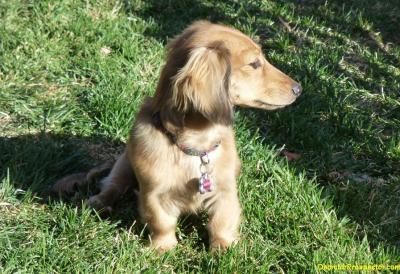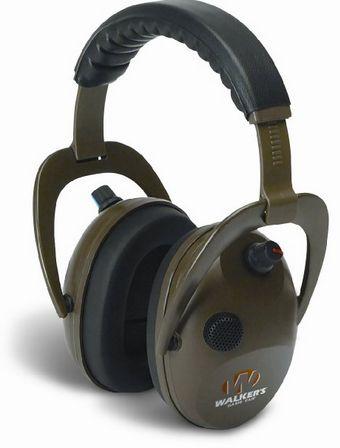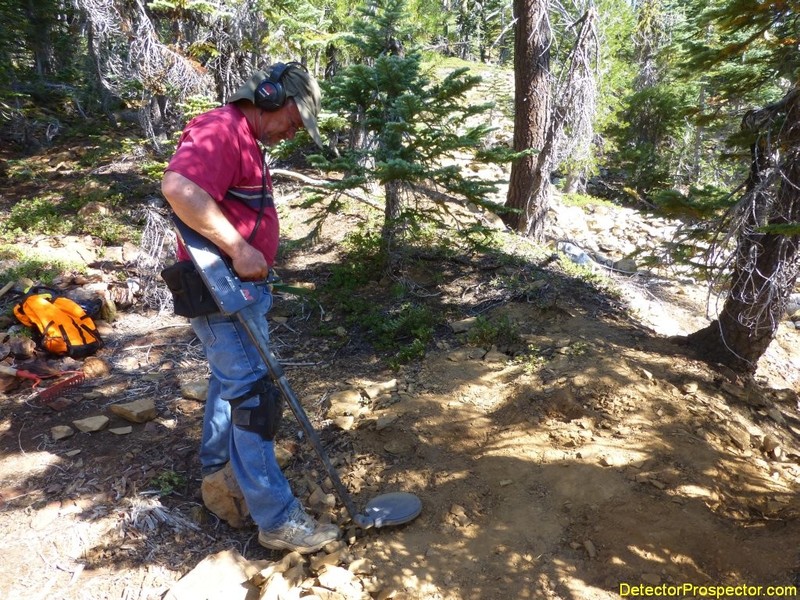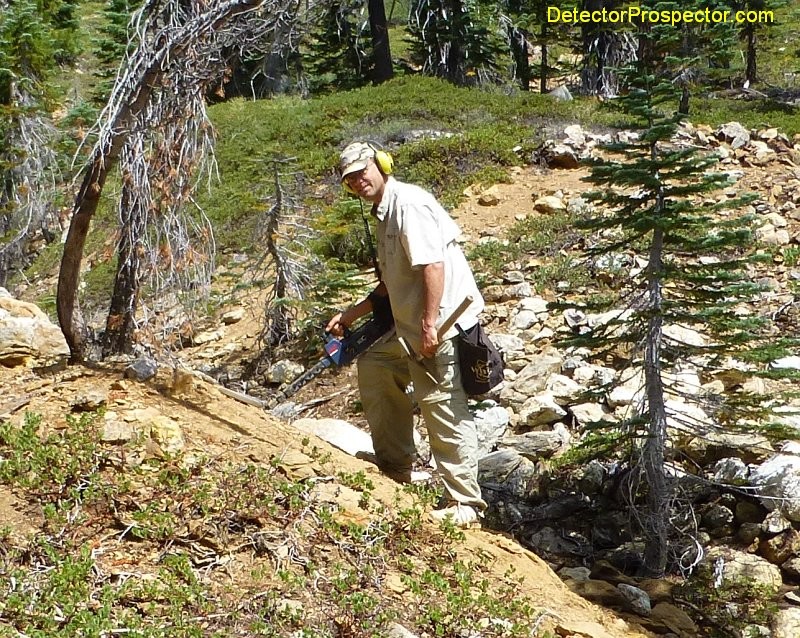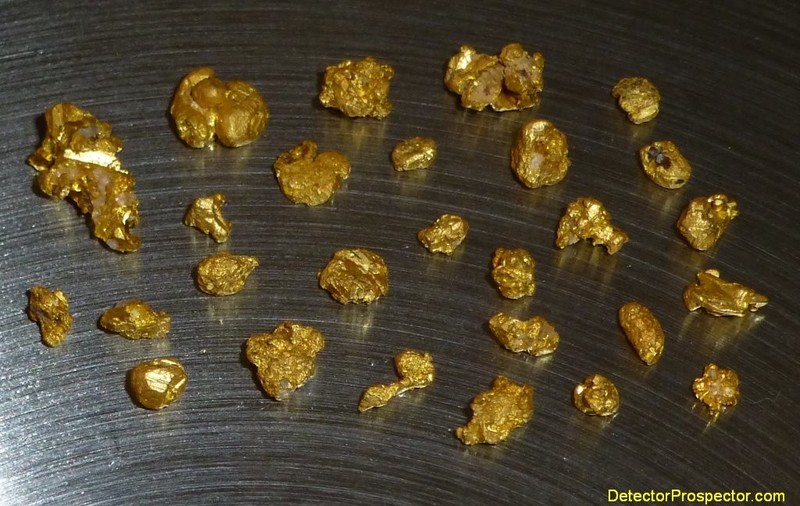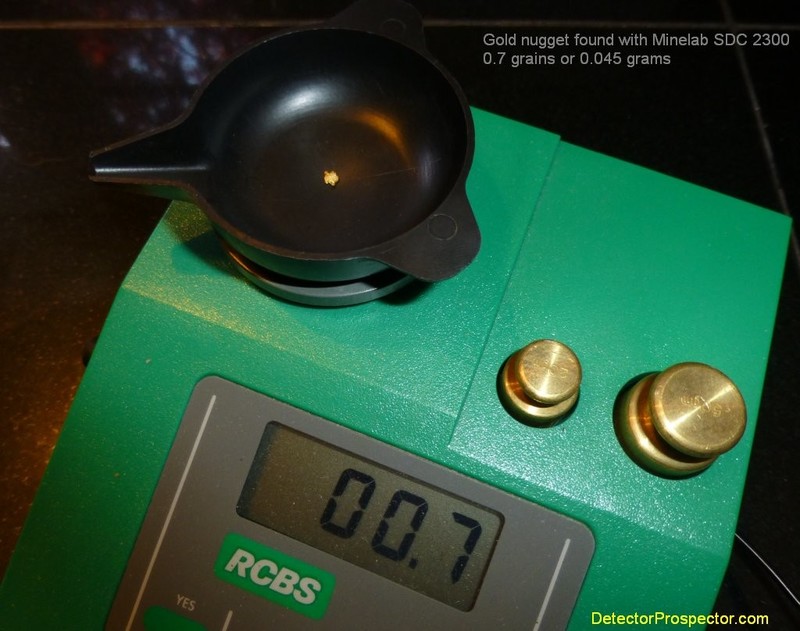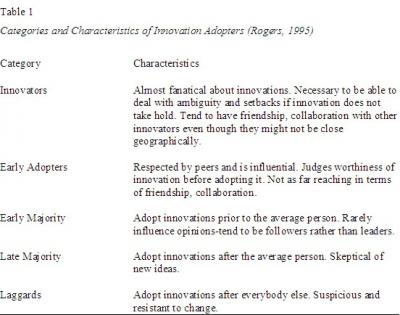-
Posts
19,790 -
Joined
Content Type
Forums
Detector Prospector Home
Detector Database
Downloads
Everything posted by Steve Herschbach
-

Gone Backpacking and Prospecting
Steve Herschbach replied to Steve Herschbach's topic in Minelab Metal Detectors
Hi AZBlackbird, I used to be a Rokon dealer. Great little units for sure and they will go where almost no other ATV will go. However, they won't go where I went this time. They can't scale bedrock chutes steep enough I nearly balk at climbing them and this darn California mess of manzanita and other brush along with vines and stuff that make going forward on foot or hands and knees all but impossible. My feet are sore and I have a collection of small puncture wounds and bruises but I survived. Story soon. Looks like you have just what you need though. Very nice setup! -
Totally awesome Ron and a great likeness. I say that now as the owner of four miniature wiener dogs so I guess that makes me an expert. Here is one of my little girls, Lilly...
-

ATX and Recon Issue - Dead Unit After Shipping
Steve Herschbach replied to Shelton's topic in Garrett Metal Detectors
As far as the Recon not working when you got it, well, you really can't know for sure it worked when it was sent to you. We know your did work when you shipped it. I am sure it is all a coincidence. I agree with Fred - check the simple things, like batteries being charged, not in backwards, etc. If possible, swap coils, as coils fail far more often than control boxes. Other than that, hope it works out! -

Minelab Patent - Constant Current Metal Detector
Steve Herschbach replied to DolanDave's topic in Minelab Metal Detectors
It has been well known for about a year that Minelab plans on releasing a new "Super Gold Detector" in 2015 that breaks with the SD/GP/GPX series technology. http://www.detectorprospector.com/forum/topic/209-new-minelab-flagship-super-gold-detector/ "Our next flagship gold detector will be based on new technology that we have developed and verified; technology that will dramatically improve detector performance." Whether this patent has anything to do with it I do not know and will not worry much about. Many patents are filed, many that never see actual products related to them. Best bet is to just wait and see what gets announced in the upcoming year. From the link above: Constant Current Metal Detector with Driven Transmit Coil US 20140232408 BRIEF SUMMARY OF THE INVENTION According to a first aspect of the invention, there is provided a metal detector used for detecting a metallic target in a soil comprising: a) transmit electronics having a plurality of switches for generating a repeating transmit signal cycle, the repeating transmit signal cycle including at least one receive period and at least one non zero transmit coil reactive voltage period, the at least one non zero transmit coil reactive voltage period is different from the at least one receive period; a transmit coil having an inductance connected to the transmit electronics for receiving the repeating transmit signal cycle and generating a transmitted magnetic field; c) a receive coil for receiving a received magnetic field during at least one receive period and providing a received signal induced by the received magnetic field; d) one or more negative feedback loops for sensing a current in the transmit coil during the at least one receive period to provide a control signal, and based on the control signal, the one or more negative feedback loops control a magnitude of a voltage and/or duration of the at least one non zero transmit coil reactive voltage period; and e) receive electronics connected to the receive coil for processing the received signal during at least one receive period to produce an indicator output signal, the indicator output signal including a signal indicative of the presence of a metallic target in the soil; wherein when the inductance of the transmit coil is modulated by the soil during an operation of the metal detector, the one or more negative feedback loops change the magnitude of a voltage and/or duration of the at least one non zero transmit coil reactive voltage period to maintain an average value of the current during at least one receive period in a cycle to be substantially the same value as an average value of the current during at least one receive period in any other cycle. According to a second aspect of the invention, there is provided a method for detecting a metallic target in a soil using a metal detector, the method comprising: a) generating a repeating transmit signal cycle, the repeating transmit signal cycle including at least one receive period and at least one non zero transmit coil reactive voltage period, the at least one non zero transmit coil reactive period is different from the at least one receive period; receiving the repeating transmit signal cycle using a transmit coil having an inductance connected to the transmit electronics for generating a transmitted magnetic field; c) receiving a received magnetic field using a receive coil during at least one receive period and providing a received signal induced by the received magnetic field; d) sensing a current in the transmit coil during at least one receive period to provide a control signal, and based on the control signal, controlling a magnitude of a voltage and/or duration of the at least one non zero transmit coil reactive voltage period; and e) processing the received signal during at least one receive period to produce an indicator output signal, the indicator output signal including a signal indicative of the presence of a metallic target in the soil; wherein when the inductance of the transmit coil is modulated by the soil during an operation of the metal detector, the step of controlling a magnitude of a voltage and/or duration of the at least one non zero transmit coil reactive voltage period includes changing the magnitude of a voltage and/or duration of the at least one non zero transmit coil reactive voltage period to maintain an average value of the current during at least one receive period in a cycle to be substantially the same value as an average value of the current during at least one receive period in any other cycle. According to a third aspect of the invention, there is provided a computer readable medium comprising instructions for causing a processor to implement the method of the second aspect. -
The Falcon MD20 will easily pick out tiny gold like that, but as already mentioned it is more a probe/pinpointer than a metal detector and so has a very limited range of about an inch and therefor limited applications. I am sure my Gold Bug 2 or White's GMT with small coils would hit on those samples, but again we are talking only a few inches at best. Depth/distance is directly related to target size, and unfortunately the effect is only cumulative to a small degree. The problem is with dispersed small gold. If a detector cannot pick up one tiny piece of gold, it also cannot pick up 1000 of those same tiny pieces sitting next to each other. Even in a vial there is barely enough contact between pieces to enhance the signal, which is why you see people complaining all the time that a detector will not pick up a vial full of very small gold. The same issue arises with small gold chains with tiny links. You mention "cold rocks". A hot rock is simply a rock that does not match the current ground balance setting in one direction, and which therefore signals as if it is a metallic target. A "beep-beep" if you will. A cold rock is also just a rock which does not match the current ground balance setting, but in the opposite direction, producing a distinctive null followed by overshoot effect that can best be described as "boing-boing". If a detector has sufficient ground balance range both hot rocks and cold rocks can be ground balanced out, but then the main ground mass will be out of balance, causing it to signal. Hot rocks and cold rocks only exist as out of place items. If all the surrounding ground were the same composition as the cold rock or hot rock, you would simply ground balance the detector and they would cease to exist. Because hot rocks and cold rocks are simply an accidental artifact of the ground balancing system, manipulating the control can change many hot rocks into cold rocks and vice versa. They only exist relative to the current ground balance setting. If a detector could have two ground balance settings, like the old Tesoro Diablo uMax, you could ground balance out both the overall ground plus the hot rocks or cold rocks. Hot rock and cold rock effects are rapidly masked by the overlying soils. So a large vein of material that is markedly different than the surrounding ground can be detected, but generally not at great depths. Like everything else metal detecting, it would depend on the difference between the main ground mass and the target material, and the size of the target material. For example, a vein of magnetite in relatively moderate ground would produce a large cold rock type signal. the depth it could be detected at would depend on how pure the magnetite is, and how much actual surface area is presented towards the coil of the detector. A vein a foot across might be detected to a foot or two with most detectors. The reverse happens and does catch some people. If you have iron mineralized bedrock that is cut by a vein of bull quartz (pure white quartz) the detector is ground balanced to the mineralized bedrock and so will produce a positive signal over the quartz. It sounds like there is gold in the quartz. But unfortunately it is the lack of iron mineralization in the quartz producing a classic hot rock sound from barren quartz! Typically these types of things are the realm of induction balance (VLF) detectors and much less so something that cam happen with pulse induction detectors. Your question is interesting because in theory old style two box detectors like the Fisher Gemini 3 White's TM808 http://www.whiteselectronics.com/tm-808 can be used to locate large veins buried under topsoil if the are large enough and distinct enough from the ground mass. I would however hold out very little hope of this being applicable to your situation as you would need either a huge quartz vein buried in mineralized soil or lots of magnetite mixed in with that gold and quartz, and then the overall vein buried in relatively mild soil. There is no hard and fast answer though, it just depends on the specific situation. The TM808 is probably the easier machine to use, but the Gemini 3 has the ability to be separated into transmitter and receiver components, and operated held far apart by two operators, basically creating a huge search coil that could be, for instance, about 20 feet in diameter. The Gemini 3 manual at http://www.fisherlab.com/hobby/manuals/Gemini-3-07.24.14-Printer.pdf details this: "Two operators line up at least 20 feet apart,one with the receiver and one with the transmitter, parallel to the assumed direction of the buried conductor. The transmitter and receiver should be in line with each other, facing the same direction. 1. Keeping the receiver and transmitter sections in line, the two operators can now walk their predetermined search pattern. The SENSITIVITY control should be checked periodically to ensure that the receiver is tuned just below the “air coupling” threshold. 2. If both operators cross the same conductive body (pipe, cable, ore vein, etc.) at approximately the same time, the receiver tone and meter will rise to indicate its presence. The receiver operator should alert the transmitter operator that they have detected a conductive object. 3. The receiver operator should then hold his position while the transmitter operator moves back and forth for the strongest receiver response. At this point, the transmitter operator should stop and place the instrument on the ground with the handle grip on top. 4. The receiver operator can then pinpoint the buried object by moving the receiver back and forth in line with the transmitter. The object should be directly beneath the point of maximum response. A dated but excellent reference on this and other geophysical prospecting methods is the Handbook of Geophysical Prospecting Methods for the Alaskan Prospector downloadable at http://137.229.113.30/webpubs/mirl/report_no/text/mirl_n19.pdf See page 46 "Electromagnetic Methods". None of this is a sales pitch. Frankly, we all want a magic box to make the hard work easier, but in reality you need some very favorable conditions for these methods to be easy and clear cut. More often results are fuzzy at best, requiring a lot of operator expertise and interpretation. Metal detectors as we know them respond to both conductive and magnetic effects. Magnetometers are often more effective, employing just magnetic differences in materials. So here are a couple references that expand on all this. Many of the prospecting concepts are identical to those you would see with electromagnetic devices. Applications Manual for Portable Magnetometers Applications of Geophysics to Gold Exploration In South Africa Exploration of Placer Gold Deposits by Geomagnetic Surveys Hope this helps.
-

Cordless Headphones
Steve Herschbach replied to ~LARGO~'s topic in Metal Detector Advice & Comparisons
Hi Chris and Gary, Chris, what Gary is talking about is not wireless Bluetooth headphones, but headphones that amplify surrounding sounds. Basically huge hearing aids. The idea in Gary's case I assume to amplify the rather weak SDC 2300 main speaker audio output. I am curious to hear how it works out for you Gary. Really not a whole lot different than my putting in my hearing aids except for the ability to have the headphone tune in on specific frequencies, like that put out by the SDC speaker, while ignoring other noises, like perhaps the wind noise. Interesting idea. Not exact but similar product from same manufacturer http://www.amazon.com/Walkers-Game-Alpha-Power-Muffs/dp/B003DWPAQ6/ref=pd_cp_vg_3 -

Gone Backpacking and Prospecting
Steve Herschbach replied to Steve Herschbach's topic in Minelab Metal Detectors
I am!Gary, my solar panel charges a set of batteries in 3-4 hours. However, we pack in one day, hunt 3 days for sure, maybe a fourth. So I have three sets of fully charged batteries with me, each set good for a day unless I go long, which is possible. So I have two more sets of alkalines just in case. Two sets weigh less than the panel and charger so there you go. Packing out what I pack in is not an issue, anything I can pack in I can pack out. In theory all I need is the solar panel with charger and two sets of batteries, since the panel charges the batteries in half the time it takes to use them. Just put fresh set in detector in morning and leave other set to charge, and swap whenever. This trip was right at the tipping point - any longer and I would have went solar. But as is I think just batteries will be fine. I will know in a few days! -

Gone Backpacking and Prospecting
Steve Herschbach replied to Steve Herschbach's topic in Minelab Metal Detectors
Good luck to you Chris and thanks for keeping an eye on the forum. The IP Board spam blocking is superb and the members the best so I expect no issues. Thanks moxford. -
A guy I met at Moore Creek mentioned he was going to do some "arduous backpacking" looking for gold. It has been my goal to hit remote areas with the SDC 2300 so I asked if he could use a partner. It has been many years since I have lived out of a backpack for days on end, so this will be a good chance to tune my outfit. Got my little tent, sleeping bag, pad, food, emergency gear, SDC 2300, and related prospecting gear into a 45 lb pack. Not a lot of places to save weight there. Could leave the tent and go with my bivvy bag but no reason to go that hardcore on this trip since we are establishing a base camp then working out of it. A tent works better for that. The SDC is critical to keeping things manageable, not so much for the weight but in being nice and compact. My GPX 5000 with batteries and harness would pretty much fill my pack with no room for anything else. Anyway, I managed to stay in touch daily while in Alaska, but will probably be offline for this trip. There is almost never any need on this forum to take administrative actions, but by chance I did have to knock one of those guys trying to sell gold and diamonds off the classifieds a couple days ago. So I have made Chris Ralph a forum moderator, just in case anything really egregious occurs. Chris will be out doing his own prospecting but will be able to check in periodically from where he is. Other than that, good luck to anyone else who is out and about. I will report back next week. We head out this afternoon.
-
Does 6.5 ounces at 12" count? http://golddetecting.4umer.net/t19607-a-great-day-for-the-2300
-
Yeah Chris, we will hit those places next month. There are no stupid questions Fred. You made me think about what I really thought and I spit it out. No regrets and nothing to take back - the SDC is one hot little PI and that is all there is to it. There will be lots more gold found by SDC owners posted in the coming months.
-
Nothing wrong with the comparison per se, just more in what it leaves out. As you say, the GPX can do better in skilled hands, and certainly nothing matches it for overall performance in a wide range of ground conditions. If you go back you will see I recommended the ATX as an alternative if you want new with warranty and want to stay in the $3000 for two detectors range. Which I see Ken seconded. If I had to get a PI to nugget hunt and was prohibited from getting a Minelab the Garrett ATX is what I would get. Most of my caveats regarding the machine for nugget detecting have more to do with ergonomics than capability. I would be happy to give up a little Minelab edge and go Garrett if they would just stuff the ATX in a 3.9 lb box instead of the 6.9 lbs it is currently saddled with.
-
I have owned each Minelab PI model in order and never regretted each upgrade. Each is better than the last, even if only by a tiny amount. They are in order: SD 2000 SD 2100 (or SD 2100v2) SD 2200 (or SD 2200v2) GP Extreme GP 3000 GP 3500 GPX 4000 GPX 4500 GPX 4800 GPX 5000 Details at Steve's Guide to the Differences Between the Minelab SD, GP, and GPX Detectors Start with the GPX 5000 and work backwards until you can find what you can afford. In a nutshell they all excel at finding large nuggets at depth. The newer the model, the more options for handling difficult ground and the better the small gold capability. Coils are compatible on all models. GP 3500 and earlier use a different battery and battery cable than the GPX 4000 and newer. The only model I would avoid is the SD 2000 as it is now considered obsolete and will not be serviced by Minelab http://www.minelab.com/gold-mining/customer-care/obsolete Locations? That is easy. Go to http://mrdata.usgs.gov/mrds/map.html# and click gold on the left. Zoom and choose location details. This is historical geologic data only, and so ground may be private, parks, claimed, etc. Finding where the gold is really is not so hard. Getting legal access is actually the biggest issue and one that can be a research nightmare. Alaska is the only state that has a relatively simple and up-to-date interactive land status mapping system. I use a combination of ONXMAPS http://www.huntinggpsmaps.com/ and Minecache http://www.minecache.com/ to at least get aimed in the right direction. Between the two I can stay off private property (ONXMAPS) and determine what sections are void of claims (Minecache). The problem with Minecache is figuring out exactly where claims are located within a section, or in dealing with claims only filed at the recorder office level. That would be recent filings, normally within last 90 days.
-

Garrett ATX vs Minelab SDC 2300
Steve Herschbach replied to Jack and dog's topic in Metal Detector Advice & Comparisons
I had Chris find a nugget with the SDC. I had my ATX with 8" coil along. I do lots of stuff that never sees the internet directly, but which forms the basis for the opinions I offer. The ATX with 8" mono coil at sensitivity 13 would not pick up the tiny nugget Chris found with the SDC when the nugget was excavated, on the surface, and edge of ATX 8" mono coil rubbed directly on the nugget. Now maybe the center 5" portion of the 10" x 12" ATX DD coil would have done better. But 8" coil to 8" coil the SDC has the edge. But we are talking really tiny, like a half grain (grain not gram) flake of gold. Seriously, this gets to be like comparing a White's GMT to a Fisher Gold Bug 2. Both will find tiny gold, but if I have to give a nod to one over the other, in my opinion the Gold Bug 2 has a slight edge on the tiny stuff. That opinion based on actual head to head tests. I will never offer an opinion on something unless I have seen it with my own eyes. So at this point I have to say the SDC has the edge for the tiny stuff compared to the ATX. Larger stuff though - my in house jury is still out on that one. Stock coil to stock coil I am curious about more than 8" coil to 8" coil. Ah well, too many questions, too little time!- 26 replies
-
- detector review
- minelab sdc 2300
-
(and 1 more)
Tagged with:
-
So this morning I am getting pressed for answers on another forum. I admit to holding back regarding the SDC as I hate to come across as some kind of person pushing a new model. But it was early and I had not had my coffee yet so I fired back an answer. A direct, no beating around the bush answer. So that is done now and I can get on with going metal detecting and looking for gold. The post http://www.nuggetshooter.ipbhost.com/index.php?showtopic=27556&p=242968 Copied here for posterity. The question was, what detectors had earlier hunted the patch where Chris and I found nearly a half ounce of small nuggets with the SDC 2300. My answer..... The question is not being avoided. I thought it was rhetorical. How the heck should I know what has hunted it before? Good question, tell me, what has hunted the ground in the last thirty years? As said, I found the patch and Chris and I hunted it with the SDC 2300s. That is the answer. It is 2014 in California and you can drive within a two minute walk from our location. There were no dig holes in the little ridge I found but I have to assume others have been there before. The valley has seen lots of detecting with dig holes and other signs of prospecting. Maybe every detector known to man passed over this spot before and missed the gold. But maybe everybody just walked around the little ridge. I just don't know. Is the intent of the question again some attempt to determine if you can hunt a patch to death with other detectors and then still go there and find gold with the SDC 2300? Sorry, but as far as I know this particular situation offers no clear evidence to answer that question. I guess the big problem is people are looking for answers, but at the same time doubting the answers and wanting ironclad tests and proofs. In my opinion the only way any individual can determine for themselves what the answers are to these types of question is to pony up, get the detectors in question, and find out for themselves. That is exactly what I do. Now, if you want my opinion I will tell you that I think the SDC 2300 can easily follow after or go head to head with a GPX 5000 and easily find gold the GPX misses. I would not have preferred to use my GPX to find the gold I found. I think it would have been harder to use, and would have missed some of the gold I found. I think 99% of GPX operators would have just passed right over this little patch and never have known it was there. So maybe some have. I am pretty sure if I was using my GPX 5000 scouting around the way I normally do I would have missed this patch. I think the SDC is simply better suited for finding these types of patches, and so I intend to keep using it to do just that. The GPX stays home for awhile. I think the smartest thing any new SDC owner can do is run post haste to every known nugget patch and hunt dawn to dusk. Before the doubters and hesitaters finally figure things out. Just my opinion. Anyone wanting proof can go get their own. Except to maybe actually believe one other opinion...... You will find more small nuggets and fine-threaded specimen gold in mineralised soils with the SDC 2300 than any other gold detector, including the GPX 5000. - Bruce Candy [Chief Scientist Minelab Electronics, GPX & SDC Inventor] That clear enough for you? [url="http://www.detectorprospector.com/gold-prospecting-equipment/minelab-sdc-2300-waterproof-gold-nugget-detector.htm"More information on the Minelab SDC 2300
-
Just curious. Ground penetrating radar? Are you looking for gold using ground penetrating radar? If so, invest less money there and more in better detectors. Your questions are simple but basically cover the entire field of gold prospecting. Where to go and what to use? Entire books can and have been written on the subject. The questions have been asked a thousand times on dozens of forums and answered with every opinion imaginable. There are no definitive answers because there are so many ways to approach the subject. Being new, sad to say, just making your trip and finding just one nugget each is going to be a challenge for you and you friend. Problem number one? The maybe 100 hours of use it takes to become reasonably proficient with a metal detector. You may just start getting the hang of it when you run out of time. You really do not have a ton of time to play with. I can spend weeks at a single location, in fact just spent two months detecting on a single creek and could go back and hunt there for years. So you really only need to find one or two locations to focus on. I am in northern Nevada, new to the area, but I think Northern California offers me better opportunities so am concentrating there. But when it gets cooler I will shift to northern Nevada, then follow the weather south, ending up in Arizona this winter. There are opportunities everywhere. If you hit a known location, say Rye Patch, you have the benefit of knowing gold has been found there. Apply yourself, you can find a nugget. If you do blue sky prospecting in unknown areas you have to expect to find nothing but if you do score the payoff can be much larger. Best best is to initially try and get into a known productive area. You can find gold with any good detector if you know what you are doing. I would go with a GPX 5000 and Gold Bug 2. Since your budget is limited substitute whatever used Minelab will replace the GPX 5000. If new with warranty is the goal a Garrett ATX and Gold Bug 2 would do the trick.
-

Garrett ATX vs Minelab SDC 2300
Steve Herschbach replied to Jack and dog's topic in Metal Detector Advice & Comparisons
The ATX is a very good detector. I do believe the SDC will hit smaller gold than the already very small gold the ATX will detect. How much difference that makes for weight in the vial however is extremely hard to say. Having both, I do prefer to grab the SDC to hunt gold but at the same time if all I had was the ATX would do well with it also. The SDC just makes it easier.- 26 replies
-
- detector review
- minelab sdc 2300
-
(and 1 more)
Tagged with:
-

Garrett ATX vs Minelab SDC 2300
Steve Herschbach replied to Jack and dog's topic in Metal Detector Advice & Comparisons
Hello Fox, and welcome to the forum! Great finds you are making there, and good machines you have. Good luck, hope you find more gold soon. It is good to hear from somebody finding gold in Australia with the ATX.- 26 replies
-
- detector review
- minelab sdc 2300
-
(and 1 more)
Tagged with:
-
My couple days came to 5.3 grams. Largest nugget 0.67 grams. Smallest weighed on my freshly calibrated digital powder scale at 0.7 grains or 0.045 grams! 5.3 grams beautiful California gold Steve found with Minelab SDC 2300 Tiny SDC gold - 0.7 grains found with Minelab SDC 2300 The gold is very close to the source as can be seen in the photos. The ground is very mineralized loaded with lots of magnetite lumps. Yet I was able to easily run my SDC 2300 on a sensitivity level of 4 for general hunting and I ran it at max of 5 when actually on a gold patch. The SDC basically exhibits no EMI noise and I was easily able to work with Chris only 50 feet away. There is little to no ground noise either. What you do get at higher sensitivity levels is noise introduced in the high gain circuitry that exhibits itself as what Jonathan refers to as a "sparky" threshold sound. Yet it is something you become accustomed to easily and the fact that such tiny nuggets stand out with no problem illustrates that. People really are just missing the point on the SDC. It is not that it will find gold other detectors will not find, though in some cases that may be the case. The real thing here is that it does it easily and quickly with no fuss or muss, no special expertise, tuning, or coils needed. As you can see in the photo I am using the new waterproof headphones for the SDC 2300. They fit my head better than the stock headphones, sound just fine, and have a much stouter cord that will be less prone to failure. Minelab should just make these the stock headphones with the SDC 2300. I also really appreciate the ability to rapidly adjust the SDC rod length and coil angle for any situation. It can be run extra short for hillside hunting, or the coil can be laid out flat as a pancake for shoving under brush. I hunted a shelf at waist height by running the coil flat and shoving it across the shelf back and forth in front of me. Great little unit. The more I use it, the more impressed I am. I have a several day backpacking trip into a remote location coming up, and have never been there before. Due to packing a tent, food, etc to cover several days, I have to choose what to take. My GPX 5000? Maybe Gold Bug Pro? How about the Gold Bug 2? Garrett ATX? Nope, they all stay home. I think the SDC has the best shot at producing gold for me so it goes and the rest stay. I do not know how to make it any clearer than that and so that is about all I am going to say on the subject going forward unless specifically asked a question. Seems like a lot of angst out there over the SDC 2300 for some reason so I think I will just keep my head down and go nugget detecting. Chris Ralph and his magic gold patch Steve Herschbach with waterproof headphones using SDC in shortest rod collapsed configuration on hillside where he found gold This post has been promoted to an article
-

Minelab CTX 3030 Beach Prospecting Presets
Steve Herschbach replied to Shelton's topic in Minelab Metal Detectors
Shelton, thanks for posting those. The CTX 3030 is one of my favorite metal detectors and one I am going to be using a lot more in the future. Those settings will come in very handy. Gary Drayton is "the man" when it comes to beach detecting with the CTX 3030 and Excalibur. He has an incredible blog at http://hardcoretreasurehunting.blogspot.com and sells some of the best books on the subject on his website at http://www.garydrayton.com I own a couple myself and highly recommend his books for anyone wanting to go to the next level in beach detecting. -
Yesterday Chris and I were discussing some of the "yeah but my machine would have got that responses" that SDC posts seem to attract. Real life is that most gold nuggets found can be found by multiple models of detectors, whatever gets over it first. Nobody is claiming otherwise, least of all Chris or I. However, anyone who wants to ignore what Bruce Candy has to say on the subject is eventually going to have to wake up to another reality. “You will find more small nuggets and fine-threaded specimen gold in mineralised soils with the SDC 2300 than any other gold detector, including the GPX 5000.” - Bruce Candy [Chief Scientist Minelab Electronics, GPX & SDC Inventor] It is not that the GPX 5000 or other detectors will not find small gold. It is that in highly mineralized ground the SDC will find them better, easier, faster. And it will flat out find small gold that a GPX 5000 cannot. Just like a GPX 5000 will find large nuggets deeper that an SDC cannot. The trick is in recognizing what it is a detector excels at and then applying it to that task. No one machine does everything perfectly, and the only real answer is to apply multiple detectors to each task because you never know for sure what might possibly be found with another model until you give it a try. I will state that in my opinion the SDC 2300 does exactly what it was designed to do and does it well. It is an amazing little machine. It is not perfect and certainly has room for improvement, but it does deliver the goods. Everyone should go back a few years and look at all the posts when the GPX 5000 came out, and all the people deriding it as yet another Minelab gimmick designed to part the unwary from their dollars. It has happened with nearly every Minelab model that comes out. It is actually classic stuff that has been studied and about which books have been written. Which category below do you fit into?
-
Thanks for a great time Chris - I had a blast! I don't care what anyone says, finding little nuggets is fun. And they do add up. My larger nugget is really interesting. Obviously formed in a tiny cavity between little quartz crystals. The crystals left distinct cavities and faces on the nugget. Will have to get a close up and post tomorrow.

